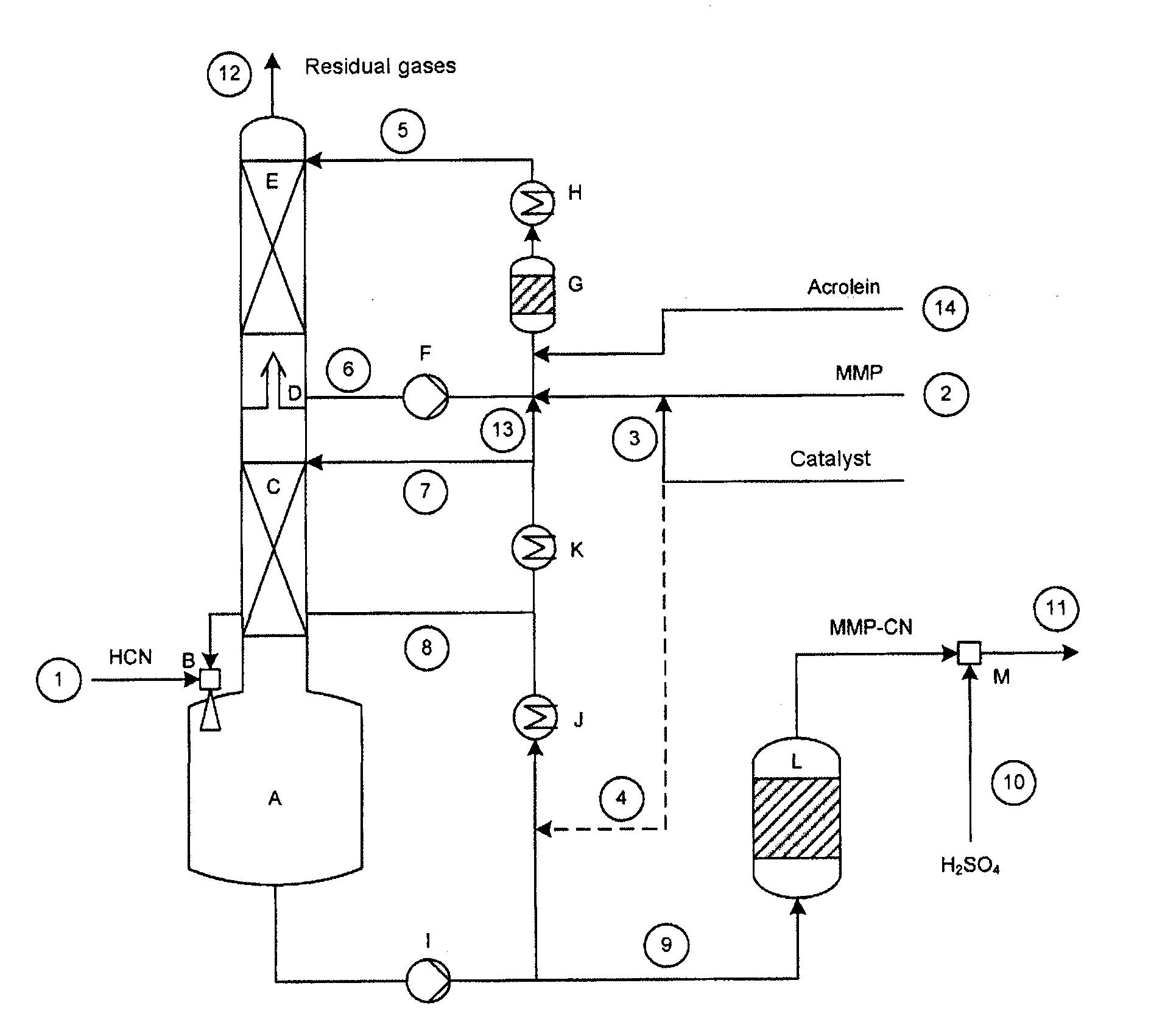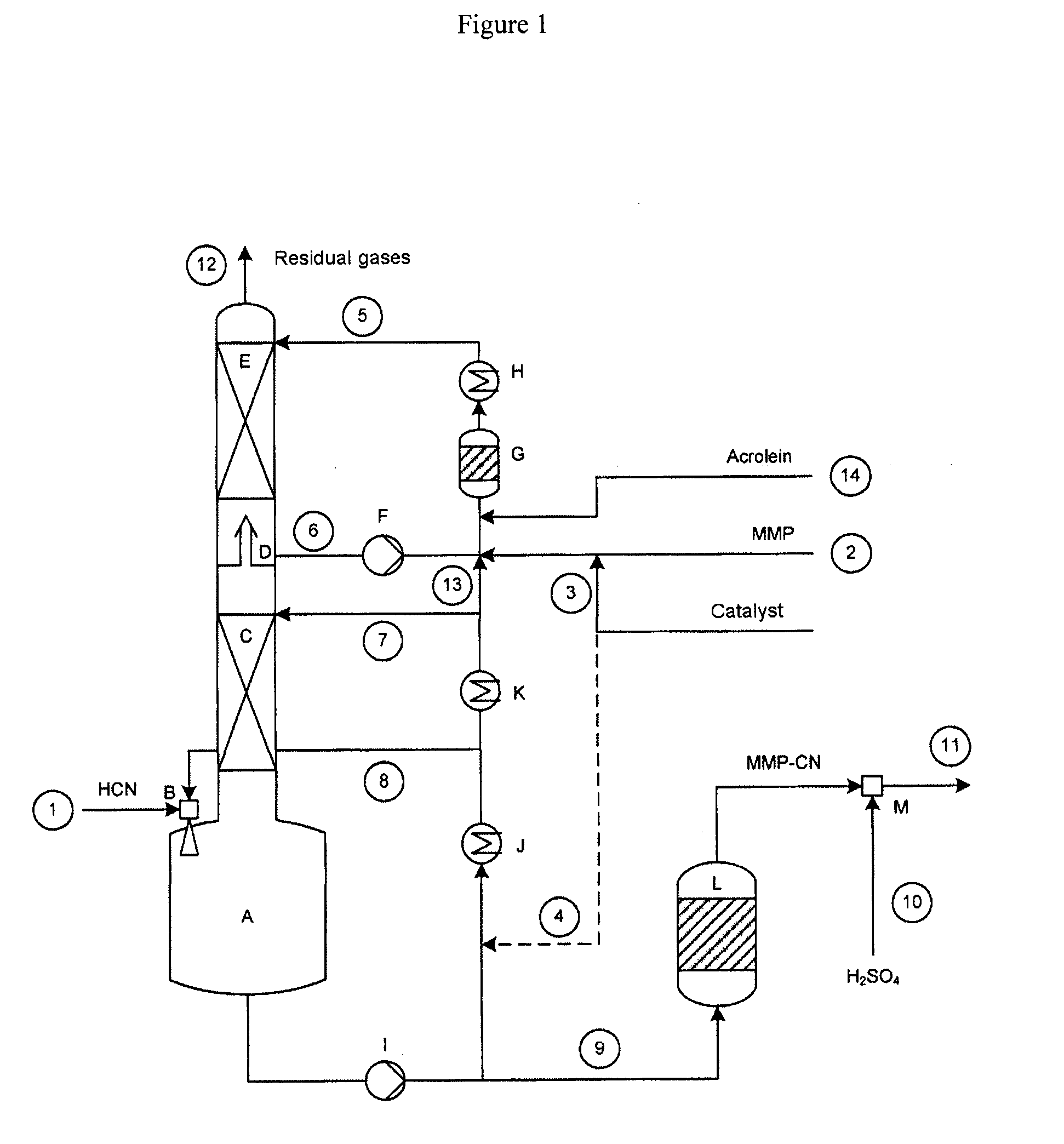Method for the production of 2-hydroxy-4-(methylthio)butyronitrile from 3-(methylthio)propanal and hydrogen cyanide
- Summary
- Abstract
- Description
- Claims
- Application Information
AI Technical Summary
Benefits of technology
Problems solved by technology
Method used
Image
Examples
example 1
[0086]A setup as shown in FIG. 1 was used, having a column of 70 mm in diameter, which was equipped with 2 ordered packings (C) and (E) and which had heights in each case of 2500 and 1700 mm. Between the ordered packings were situated an intermediate bottom phase (D), from which a stream (6) can be taken off for operating a top circuit. Beneath the column was situated the column bottom phase having a volume of 4 liters. The diagram of this device is attached (see FIG. 1).
[0087]With the stream (1), 8.98 kg / h of crude product gas from the production of hydrogen cyanide by the Andrussow method were fed via the gas blower (B) into the column bottom phase A which contained, based on weight: HCN: 8.87%, H2O: 3.88%, H2: 1.33%, N2: 76.01%, O2: 1.48%, CO: 5.67%, CO2: 1.13%, CH4: 0.39%. The incoming gas was mixed at the jet pump (B) with a circulating stream (8) of 300 kg / h. The temperature of the circulation stream was controlled here in such a manner that in the column bottom phase (A), at ...
example 2
[0091]The setup of Example 1 was used.
[0092]With the stream (1), 8.94 kg / h of crude product gas of the production of hydrogen cyanide by the Andrussow method were fed via the gas blower (B) into the column bottom phase A which contained, based on weight: HCN: 8.9%, H2O: 3.7%, H2: 1.3%, N2: 76.3%, O2: 1.5%, CO: 5.6%, CO2: 1.1%, CH4: 0.4%. The incoming gas was mixed at the jet pump (B) with a circulating stream (8) of 280 kg / h. The temperature of the circulation stream was controlled in this case in such a manner that, in the column bottom phase (A), at a filling state of 50%, a temperature of 49.8° C. prevailed. The feed stream (7) onto the ordered packing (C) had a temperature of 35° C. at 40 kg / h.
[0093]The methylthiopropionaldehyde was introduced into the reactor (G) via the feed (2) at a throughput of 2.976 kg / h. It contained, based on weight:
[0094]MMP: 96.9%, H2O: 2.8%, MC: 0.2%. Via the feed line (3), at the same time, 0.2 kg / h of a mixture of 99% by weight of MMP in the above d...
PUM
| Property | Measurement | Unit |
|---|---|---|
| Temperature | aaaaa | aaaaa |
| Temperature | aaaaa | aaaaa |
| Temperature | aaaaa | aaaaa |
Abstract
Description
Claims
Application Information
 Login to View More
Login to View More - R&D
- Intellectual Property
- Life Sciences
- Materials
- Tech Scout
- Unparalleled Data Quality
- Higher Quality Content
- 60% Fewer Hallucinations
Browse by: Latest US Patents, China's latest patents, Technical Efficacy Thesaurus, Application Domain, Technology Topic, Popular Technical Reports.
© 2025 PatSnap. All rights reserved.Legal|Privacy policy|Modern Slavery Act Transparency Statement|Sitemap|About US| Contact US: help@patsnap.com



